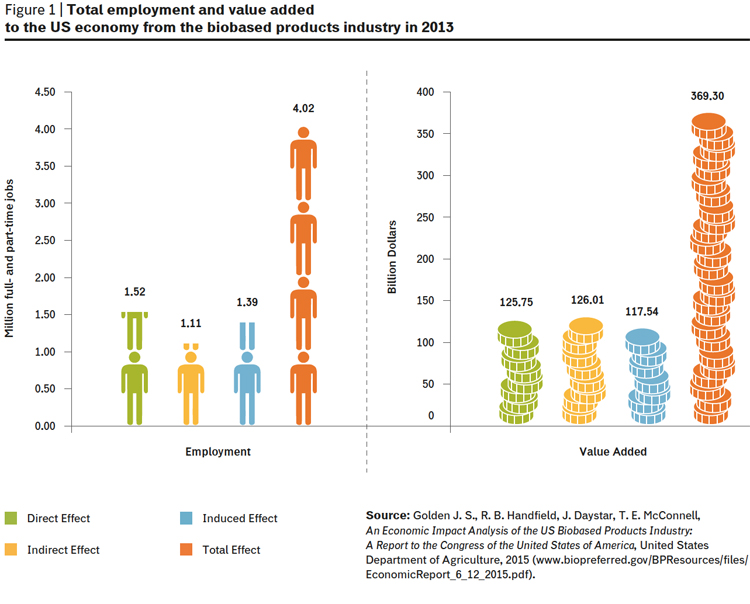
EFIB2015 speaker, Marie Wheat of the United States Department of Agriculture, talks to Joanna Dupont-Inglis about the challenges and successes of developing the USDA BioPreferred® Program.
What was the original aim of the BioPreferred®Program?
“The idea behind it was to create new markets for bio-based products and to add value to home-grown commodities thus supporting the economy in rural America. It also contributed towards increasing energy security because this is a way of using US produced renewable raw materials rather than imported fossil carbon to produce industrial products.”
How did the USDA BioPreferred® Program first begin?
“The program was first authorized in the 2002 Farm Bill by the United States Congress, reauthorized in the 2008 Farm Bill, and then again in the 2014 Farm Bill. BioPreferred® has two parts. First, there is the Federal Preferred Procurement side that designates certain products as preferred for federal purchasing by government agencies. So far we have 97 product categories designated for purchase representing around 14,000 individual products. The second part is a voluntary label, which companies can apply for by having tested their products certified in an independent lab which checks the bio-based content of the product. After certification and approval, companies are then able to use the ‘USDA Certified BioBased Product’ label which also shows the percentage of bio-based, or new carbon, content in the product.”
In the US you’ve seen great results in terms of jobs and economic growth generated by biobased industries and supported by the BioPreferred® Program. Can you tell us more about these?
“In June 2015 an economic impact analysis of the US bio-based products industry was published showing that in 2013 the US bio-based industry contributed a total of $359 billion to US GDP and around 4 million jobs. Furthermore, the study forecasts that an additional 500,000 jobs will be created by the biobased products industry over the next five years. The study shows that the direct effect of people employed by biobased industries is 1.52 million jobs, the indirect effect is 1.11 million and the induced effect is 1.39 million contributing in total to the figure of just over 4 million. Similar projections were done with GDP and with the value added and this helps show the cumulative power of the US biobased products industry. (see figure 1).”

EU renewables-based industries are hoping to follow the US’s lead in developing public procurement for bio-based products. What lessons can be learned from your experience?
“It’s a multifaceted process and that, in itself, is a challenge – so there won’t be a one size fits all solution. However, what I would say is that having leadership is a game changer in terms of creating new markets, jobs and growth for biobased products. Where leaders are talking about biobased procurement and are encouraging their development and commercialization, we can make real progress. For example, in the US, a new Executive Order was issued in March 2015 entitled ‘Planning for Federal Sustainability in the Next Decade’ promoting bio-based purchases by Federal Agencies. This will mean that starting in 2016, until an agency achieves at least 95% compliance with the biobased purchasing requirements, they must establish an annual target for the number of contracts to be awarded with biobased criteria and a dollar value of bio-based products to be delivered and reported under those contracts in the following fiscal year. This kind of measure sends a clear signal that when the US government is talking about sustainability, it considers bio-based to be a key component. This is a critical factor in building investor confidence in biobased.
“Outreach and communication is also key and we do it constantly. While it may be second nature to those who work in the field, biobased is still an ‘unknown’ to a great many people. Reaching an increasingly broad audience with the benefits of biobased products is one of the things that the BioPreferred® Program has done very effectively through many different channels. For example, we recently conducted training via live web streaming and satellite downlink, specifically for US procurement officials across a wide range of agencies around the world. Participants could download a link to join the training, ask questions and access the guidelines. Procurement is the kind of thing where training can make a big difference. We provide real, concrete guidance on how to implement a biobased public procurement. We are active in all levels of education, from explaining to a consumer what a bio-based product is, right through to explaining the technical details of federal procurement to a federal official. To increase knowledge of the program and its value, we meet with stakeholders from emerging and expanding industries on a continuing basis. “We communicate across the various sectors such as biobased chemicals, bioplastics, biobased cleaners, biobased lubricants, etc. We communicate with the people producing the products and help them understand how to get certified and receive the label so that they become part of our education outreach and can also use the label to help educate consumers. Plus, we make effective use of the BioPreferred website to educate all audiences. So it’s a plethora of activity around leadership, training and outreach and trying to do as much as we can to make the process as easy as possible.”
What other tools do you find particularly effective in raising awareness on the availability of biobased?
“Success stories are a big help in adding credibility and capturing the imagination of many people and we have several on our website. In addition, we are continually finding novel ways to reach new audiences and inform them about the biobased opportunity. Recent initiatives include work with NASA (the Kennedy Space Centre), the Department of Transportation and the Department of the Interior. Having products to touch and see makes a big difference for many people and helps make biobased products ‘real’ for them.”
How to spread BioPreferred® principles: NASA’s example
In April, the NASA/Kennedy Space Center invited the United Soybean Board (USB) and USDA BioPreferred Program to conduct biobased training for staff and key contractors. Kennedy Space Center also hosted six biobased manufacturers as a part of their Earth Day 2015 events. Their goal was to further introduce their staff and key contractors and area stakeholders to biobased products that were readily available for their use in a variety of operations. As a result, Kennedy Space Center is planning to expand its biobased product uses. In September 2015, they are installing 300 yards of Signature Accord’s biobased carpet in their Visitor’s Center. The carpet is designated by the BioPreferred program (a “qualified” product for preferred Federal Government purchasing). NASA and Kennedy Space Center are demonstrating that Federal Agencies are working to meet the mandatory acquisition requirements and showcasing the benefits of biobased products that visitors and members of the public can see and touch.
 |
|
STS-124, 2008. Courtesy NASA
|
In the EU we know that farmers are often unaware of the potential of biobased products to add value to their production. How do you tackle this at the USDA?
“USDA has officers in the Rural Development Programme in every state across America who are dedicated to informing farmers of this potential and for explaining the BioPreferred® Program. In addition, and again this goes back to effective leadership, whenever possible our leaders ensure that they mention the Program at high level events where primary producers will be present.”
What, in your view, is the next greatest opportunity for the BioPreferred® Program and what is the greatest challenge to be overcome?
“The greatest opportunity is to create more markets on a global scale. It is an unbelievable potential waiting to be captured worldwide. In terms of the pitfalls or challenges for the EU to be aware, it’s really important to have both labelling and public procurement systems ready to go at the same time. Having one label indicating that the product bearing it should also be federally procured really helps simplify things for everyone involved. In the US, as our labelling system came online after our public procurement system, we had lists of items that were designated for procurement with no label. Initially this presented a hurdle to a quicker adoption and acceptance of the program.”
Your enthusiasm for the program and for its potential is clear. What is it that you enjoy most about your job?
“I love the idea that I work every day to create greater economic opportunity for people around the world using biobased products. Right now we have companies from 42 countries participating in our Program and applying for our label. To me this speaks volumes about how we are adding value around the world and I’m glad to be part of that.”
Usda BioPreferred® Program, www.biopreferred.gov/BioPreferred/.



